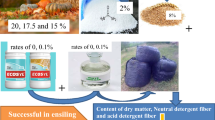Abstract
Sixteen rumen fistulated Ethiopian Menz type sheep were used in a completely randomized block design (CRBD) in experiment 1. Unchopped teff straw was fed alone or supplemented with either 100, 150 or 200 g/d of sun-dried vernonia leaves. The chemical compositions of fresh, boiled, water-soaked and sun-dried vernonia and soluble carbohydrate (SC) loss by boiling were determined. In experiment 2,25 growing Ethiopian Menz type sheep, were fed teff straw alone or supplemented with 120 g (DM) of either boiled (B) or soaked (S) fresh vernonia with or without molasses (M) (50 g). SC lost by boiling fresh vernonia for 15, 30, 45 or 60 min was determined.
In experiment 1, boiling increased the nitrogen (N) concentration in vernonia but sun-drying reduced it. N bound to fibre (NDF-N) was reduced by boiling but not by soaking. SC loss increased with boiling time. Supplementation did not affect the degradation constants (a, b, PD, c) of teff straw, but DM disappearance was increased (p<0.05) at 76 and 120 h of incubation. Intake of sun-dried vernonia was poor but increased with quantity offered. Intakes and digestibilities of DM, OM and the fibre fractions were marginally higher (p<0.05) in the supplemented diets. Nitrogen balance in the supplemented diets was low due to increased faecal and urinary excretion. In experiment 2, rumen NH3−N was higher for the boiled treatments compared to the soaked treatments. Acceptability at both 2 and 4 h was highest for BM, followed by SM, B and S. Boiling for 30 min, but not soaking, enhanced the acceptability of vernonia, suggesting that a pretreatment may enhance the feed value of vernonia.
Similar content being viewed by others
References
Ahn JH, Robertson BM, Elliot R, Gutteridge RC and Ford CW (1989) Quality assessment of tropical browse legumes. Tannin content and protein degradation. Anim Feed Sci Technol 27: 147–156
Alawa JP (1991) Nitrogen excretion by sheep fed low-protein roughage diets. Small Rum Res 6: 279–284
Association Official Analytical Chemist (OAAC) (1984) Official Methods of Analysis, 15th ed, pp 69–88. Washington DC
Atta-Krah AM and Okali DU (1986) Report, Advisory Group Meeting on Use of Nuclear Techniques in Studying Roles of Trees in Restoring and Maintaining Soil Fertility. IAEA, Vienna
Begrey S and Leonard EA (1992) Take two roots; call me... How wild animals use nature's medicine chest. Newsweek, February 3
Buttler GW and Bailey RW (1973) Chemistry and Biochemistry of Herbage, Vol 1. Academic Press, London and New York
Campling RC (1970) Physical regulation of voluntary intake. In: Phillipson AT (ed) Physiology of Digestion and Metabolism in the Ruminant, pp 226–234. Oriel Press, Newcastle Upon Tyne, UK
Doyle PT (1988) Utilization of clover diets by sheep. 111. Palatability of a mature subterranean clover hay. Aust J Agric Res 39: 891–898
Egan AR and Moir RJ (1965) Nutritional status and intake regulation in sheep. 1. Effect of duodenally infused single dose of casein, urea and propionate upon voluntary intake of a low-protein roughage by sheep. Aust J Agric Res 16: 437–449
El Hassan SM (1994) Yeast culture and multipurpose fodder trees as feed supplements for ruminants. PhD Thesis. University of Aberdeen, Scotland, UK
Gherardi SG, Black JL and Colebrook WF (1991) Effect of palatability in voluntary feed intake by sheep. II. The effect of altering the palatability of a wheaten hay on long-term intake and performance. Aust J Agric Res 42: 585–598
Goering HK and van Soest PJ (1970) Forage Fibre Analysis (Apparatus, Reagents, Procedures and Some Applications). Agricultural Handbook, USDA No 379, Washington DC
Gohl B (1981) Tropical Feeds: Feed Information Summaries and Nutritive Values. FAO Animal Production and Health Series No 12, Rome
Greenhalgh JFD and Reid GW (1971) Relative palatability to sheep of straw, hay and dried grass. Br J Nutr 26: 107–116
Huhtanen P (1987) The effects of intraruminal infusions of sucrose and xylose as the nitrogen and fibre digestion in cattle receiving diets of grass silage and barley. J Agric Sci Finl 59: 405–424
Hutchinson J and Dalziel JM (1963) Flora of West Tropical Africa, Vol 2 (F. N. Hepper (ed)). Crown Agents for Overseas Governments and Administrations, London
Khalili H and Huhtanen P (1991a) Sucrose supplements in cattle given grass silage-based diet. 1. Digestion of organic matter and nitrogen. Anim Feed Sci Technol 33: 247–261
Kahlili H and Huhtanen P (1991b) Sucrose supplements in cattle given grass silage-based diet. 2. Digestion of cell wall carbohydrates. Anim Feed Sci Technol 33: 263–273
Khalili H (1992) Soluble carbohydrates is the utilization of forages by cattle. PhD Thesis. University of Helsinki, Finland
Mahyuddin, P, Little DA and Loury JB (1988) Drying treatment drastically affects feed evaluation and feed quality with certain tropical forage species. Anim Feed Sci Technol 22: 69–78
McDonald P, Edwards RA and Greenhalgh JFD (1982) Animal Nutrition. 3rd ed. Longman, London
Ministry of Agriculture, Fisheries and Food (1981) The analysis of Agricultural materials, pp 38–37
Morgan EC and Trinder H (1986) The composition and nutritional value of some tropical and sub-tropical by products In: Orskov ER (ed) By-Products and Waste in Animal Feeding. Br Soc Anim Prod, Occasional Publ
Mould FL, Orskov ER and Mann SO (1983) Associative effectis of mixed feeds. 1. Effects of type and level of supplementation and the influence of the rumen fluid pH on cellulolysisin vivo and dry matter digestion of various roughages. Anim Feed Sci Technol 10: 15–30
Okigbo BN (1982) In: MacDonald LH (ed) Agroforestry in the African Humid Tropics, pp 41–45. United Nations University, Tokyo
Ologunde MO and Ayorinde FO, Shepard RK, Afolabi OA and Oke OL (1992) Sterols of seed oils ofVernonia galanensis, Amaranthus cruentus, Amaranthus caudatus, Amaranthus hybridus andAmaranthus hypochondriacus growth in the humid tropics. J Sci Food Agric 58: 221–225
Orskov ER and McDonald I (1979) The estimation of protein degradability in the rumen from incubation measurements weighed according to rate of passage J Agric Sci Camb 92: 499–503
Palgrave KC (1983) Trees of Southern Africa (Moll EJ (ed)). Struik Publishers
SAS Institute (1987) Procedures Guide for Personal Computers, Version 6.
SAS Inst Inc, Cary NC (1988), SAS/Stat Users Guide Release 6.03 SAS Inst Incorporation, Cary, NC
Siaw DEKA, Osuji PO and Nsahlai IV (1993) Evaluation of multipurpose tree germplasm. The use of gas production and rumen degradation characteristics. J Agric Sci Camb 120: 319–330
Tan PV and Bryant MJ (1991) The effects of dietary supplements of fish meal on the voluntary food intake of store lambs. Anim Prod 52: 271–278
Teguia A, Tchoumboue J, Mayaka BT and Tankou CM (1993) The growth of broiler chickens as affected by the replacement of graded levels of maize by sweet potato leaves (Ipomoea batatas) or Ndole (Vernonia spp.) in the finisher diet. Anim Feed Sci Technol 40: 233–237
Tolera A (1990) Animal production and the feed resource constraints in Welayta Sodo and the supplementary value ofDesmodium intortum, Stylosanthes guianensis andMacrotyloma axillare when fed to growing sheep feeding on a basal diet of maize stover. MSc Thesis. Agricultural University of Norway
Weston RH and Davis P (1986) Low palatability as a constraint to the intake of wheat straw diet by sheep. Proc Nutr Soc Aust 11: 172–175
Wilson AD (1977) The digestibility and voluntary intake of the leaves of trees and shrubs by sheep and goats. Aust J Agric Res 28: 501–508
Author information
Authors and Affiliations
Rights and permissions
About this article
Cite this article
Bonsi, M.L.K., Osuji, P.O., Tuah, A.K. et al. Vernonia amygdalina as a supplement to teff straw (Eragrostis tef) fed to Ethiopian Menz sheep. Agroforest Syst 31, 229–241 (1995). https://doi.org/10.1007/BF00712076
Issue Date:
DOI: https://doi.org/10.1007/BF00712076




